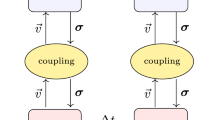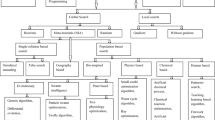Abstract
In this paper, by means of computational fluid dynamics, a significant study has been made on the effects of geometric parameters of wing with capability of flying efficiently and cost-effectively at supersonic condition. Multi-objective optimization has been performed for the aerodynamic shape optimization of the wing configuration. The three-dimensional wing shape defined by four design variables is optimized. For achieving the most desirable aerodynamic efficiency (lift-to-drag ratio), Response Surface Method and Genetic Algorithm is utilized. To ensure the reliability of the solution and validating the numerical evaluation, flow around a delta wing is simulated and results are compared with credible numerical works. Furthermore, the particular design variables, which have serious effects on the objective functions, are found. Wing sweep angle along with aspect ratio has strong effects on the main outputs. Given that the current flow regime is supersonic, counteracting the negative effects of shock waves is one the most important design points. Among the studied parameters, leading edge sweep angle has the greatest impact on the main objectives of this research and it is the primary factor for delaying the formation of shock waves over the wing surface. Lift and drag coefficients, as primary objective functions, have higher sensitivity to changes in aspect ratio. By comparison to best geometry among initial cases, aerodynamic efficiency is increased by approximately 15% as a result of optimization study of this supersonic wing geometry.



























Similar content being viewed by others
References
Anderson JD (1997) A history of aerodynamics and its impact on flying machines. Cambridge University Press, Cambridge
Secanell M, Suleman A, Gamboa P (2006) Design of a morphing airfoil using aerodynamic shape optimization. AIAA J 44:1550–1562. https://doi.org/10.2514/1.18109
Lock RC, Bridgewater J (1967) Theory of aerodynamic design for swept-winged aircraft at transonic and supersonic speeds. Prog Aerosp Sci 8:139–228. https://doi.org/10.1016/0376-0421(67)90004-8
Sadraey M (2012) Aircraft design: a systems engineering approach. Wiley, Amsterdam
Talay TA (2012) Introduction to the aerodynamics of flight. NASA, New York
Yoshida K (2009) Supersonic drag reduction technology in the scaled supersonic experimental airplane project by JAXA. Prog Aerosp Sci 45:124–146. https://doi.org/10.1016/j.paerosci.2009.05.002
Yuhara T, Rinoie K, Makino Y (2014) Conceptual design study on LH2 fueled supersonic transport considering performance and environmental impacts. AIAA SciTech Forum. https://doi.org/10.2514/6.2014-0028
Hitchens F (2015) The encyclopedia of aerodynamics. Andrews UK Limited, London
Ueda Y, Yoshida K, Matsushima K, Ishikawa H (2014) Supersonic natural-laminar-flow wing-design concept at high-reynolds-number conditions. AIAA J 52:1294–1306. https://doi.org/10.2514/1.J052555
Fu Z, Bai J, Liu N, Zhang Y, Xu J (2017) Planform parameter study and wing twist distribution optimization of a supersonic transport configuration. AIAA Meeting Papers. https://doi.org/10.2514/6.2017-2198
Li P, Sobieczky H, Seebass R (1995) A design method for supersonic transport wings. AIAA Meet Pap. https://doi.org/10.2514/6.1995-1819
Aerion Corporation Press Conference (2014) Aerion AS2 poised to become first supersonic business jet. http://www.aerionsupersonic.com/press-center/. Accessed 01 June 2017
Elmer K, Welge H, Salamone J, Cowart R (2013) SCAMP: supersonic passenger transport transonic acceleration flight profiles with considerations of focused sonic boom. AIAA Meet Pap. https://doi.org/10.2514/6.2013-1065
Liebhardt B, Gollnick V, Luetjens K (2011) Estimation of the market potential for supersonic airliners via analysis of the global premium ticket market. AIAA ATIO Conf. https://doi.org/10.2514/6.2011-6806
Mavris DN, Hayden WT (1996) Formulation of an IPPD methodology for the design of a supersonic business jet. Georgia Institute of Technology. http://hdl.handle.net/1853/6329. Accessed 07 June 2017
Chudoba B, Coleman G, Huang X, Huizenga A, Czysz P, Butler C (2006) A feasibility study of a supersonic business jet (SSBJ) based on the Learjet airframe. AIAA Meet Pap. https://doi.org/10.2514/6.2006-28
Sturdza P (2007) Extensive supersonic natural laminar flow on the Aerion business jet. AIAA Meeting Papers. https://doi.org/10.2514/6.2007-685
Kim Y, Jeon Y, Lee D (2006) Multi-objective and multidisciplinary design optimization of supersonic fighter wing. J Aircraft. https://doi.org/10.2514/1.13864
Reuther J, Alonso JJ, Rimlinger MJ, Jameson A (1999) Aerodynamic shape optimization of supersonic aircraft configurations via an adjoint formulation on distributed memory parallel computers. J Comput Fluid 28:675–700. https://doi.org/10.2514/6.2002-2838
Kiyici F, Aradag S (2015) Design and optimization of a supersonic business jet. AIAA AVIATION Forum. https://doi.org/10.2514/6.2015-3064
Parashar S, Bloebaum C (2006) Multi-objective genetic algorithm concurrent subspace optimization (MOGACSSO) for multidisciplinary design. AIAA Meet Pap. https://doi.org/10.2514/6.2006-2047
Kenway GKW, Martins JRRA (2015) Multipoint aerodynamic shape optimization investigations of the common research model wing. AIAA J 10(2514/1):J054154
Lyu Z, Xu Z, Martins J R R A (2014) Benchmarking optimization algorithms for wing aerodynamic design optimization. In: the 8th International conference on computational fluid dynamics (ICCFD8). Chengdu, Sichuan
Holland J (1992) Adaption in natural and artificial systems. MIT Press, Cambridge
Goldberg DE (1989) Genetic algorithms in search, optimization and machine learning. Wesley Longman Publishing, Boston
Sforza P (2014) Commercial airplane design principles, 1st edn. Butterworth-Heinemann, Oxford, pp 119–212
Wu Z, Zhang Q, Bao T, Li L, Deng J, Hu Z (2016) Experimental and numerical study on ethanol and dimethyl ether lifted flames in a hot vitiated co-flow. J Fuel 184:620–628. https://doi.org/10.1016/j.fuel.2016.07.064
Spalart P, Allmaras S (1992) A one-equation turbulence model for aerodynamic flows. AIAA Meet Pap. https://doi.org/10.2514/6.1992-439
Dehghan Manshadi M, Jamalinasab M (2016) Optimizing a two-element wing model with morphing flap by means of the Response Surface Method. Iran J Sci Technol Trans Mech Eng. https://doi.org/10.1007/s40997-016-0067-8
Catalano P, Amato M (2003) An evaluation of RANS turbulence modelling for aerodynamic applications. J Aerosp Sci Technol 7:493–509. https://doi.org/10.1016/S1270-9638(03)00061-0
Weiss JM, Maruszewski JP, Smith WA (1997) Implicit solution of the Navier–Stokes equations on unstructured meshes. AIAA Meet Pap. https://doi.org/10.2514/6.1997-2103
Kalitzin G, Medic G, Laccarino G, Durbin P (2005) Near-wall behavior of RANS turbulence models and implications for wall functions. J Comput Phys 204:265–291. https://doi.org/10.1016/j.jcp.2004.10.018
Oyama A, Imai G, Ogawa A, Fujii K (2008) Aerodynamic characteristics of a delta wing at high angles of attack. AIAA Meet Pap. https://doi.org/10.2514/6.2008-2563
Ma D, Zhao Y, Qiao Y, Li G (2015) Effects of relative thickness on aerodynamic characteristics of airfoil at a low Reynolds number. Chin J Aeronaut 28:1003–1015. https://doi.org/10.1016/j.cja.2015.05.012
Roelof V, Farokhi S (2015) Introduction to transonic aerodynamics. Springer, New York
Dehghan Manshadi M, Rabani R (2016) Numerical evaluation of passive control of shock wave/boundary layer interaction on NACA0012 airfoil using jagged wall. Acta Mech Sin 32:792. https://doi.org/10.1007/s10409-016-0586-y
Sartor F, Timme S (2015) Reynolds averaged Navier–Stokes simulations of shock buffet on half wing body configuration. AIAA SciTech Forum. https://doi.org/10.2514/6.2015-1939
Monotgormery D (2008) Design and analysis of experimental. Wiley, Amsterdam
Reh S, Beley J, Mukherjee S, Khor EH (2006) Probabilistic finite element analysis using ANSYS. J Struct Safe 28:17–43. https://doi.org/10.1016/j.strusafe.2005.03.010
Myers RH, Montgomery DC, Anderson-Cook CM (2009) Response surface methodology: process and product optimization using designed experiments. Wiley, Amsterdam
Taguchi G (1986) Introduction to quality engineering: designing quality into products and processes. 1st edn, Quality Resources
Plackett RL, Burman JP (1946) The design of optimum multifactorial experiments, 1st edn. Oxford University Press, Biometrika
Chiba K, Makino Y, Takatoya T (2007) Multidisciplinary design exploration of wing shape for Silent supersonic technology demonstrator. AIAA Meet Pap. https://doi.org/10.2514/6.2007-4167
ANSYS® Academic Research, Release 16.0, Help System, Workbench Guide, ANSYS®, Inc
Deb K, Pratap A, Agarwal S, Meyarivan T (2002) A fast and elitist multiobjective genetic algorithm: NSGA-II. IEEE Trans Evol Comput 6:182–197. https://doi.org/10.1109/4235.996017
Lahuta M, Patek Z, Szollos A (2014) Computational aerodynamic optimization of low-speed wing. Acta Polytech 54:420–425. https://doi.org/10.14311/AP.2014.54.0420
Author information
Authors and Affiliations
Corresponding author
Additional information
Technical Editor: Márcio Bacci da Silva.
Rights and permissions
About this article
Cite this article
Manshadi, M.D., Aghajanian, S. Computational aerodynamic optimization of wing-design concept at supersonic conditions by means of the response surface method. J Braz. Soc. Mech. Sci. Eng. 40, 254 (2018). https://doi.org/10.1007/s40430-018-1150-4
Received:
Accepted:
Published:
DOI: https://doi.org/10.1007/s40430-018-1150-4




